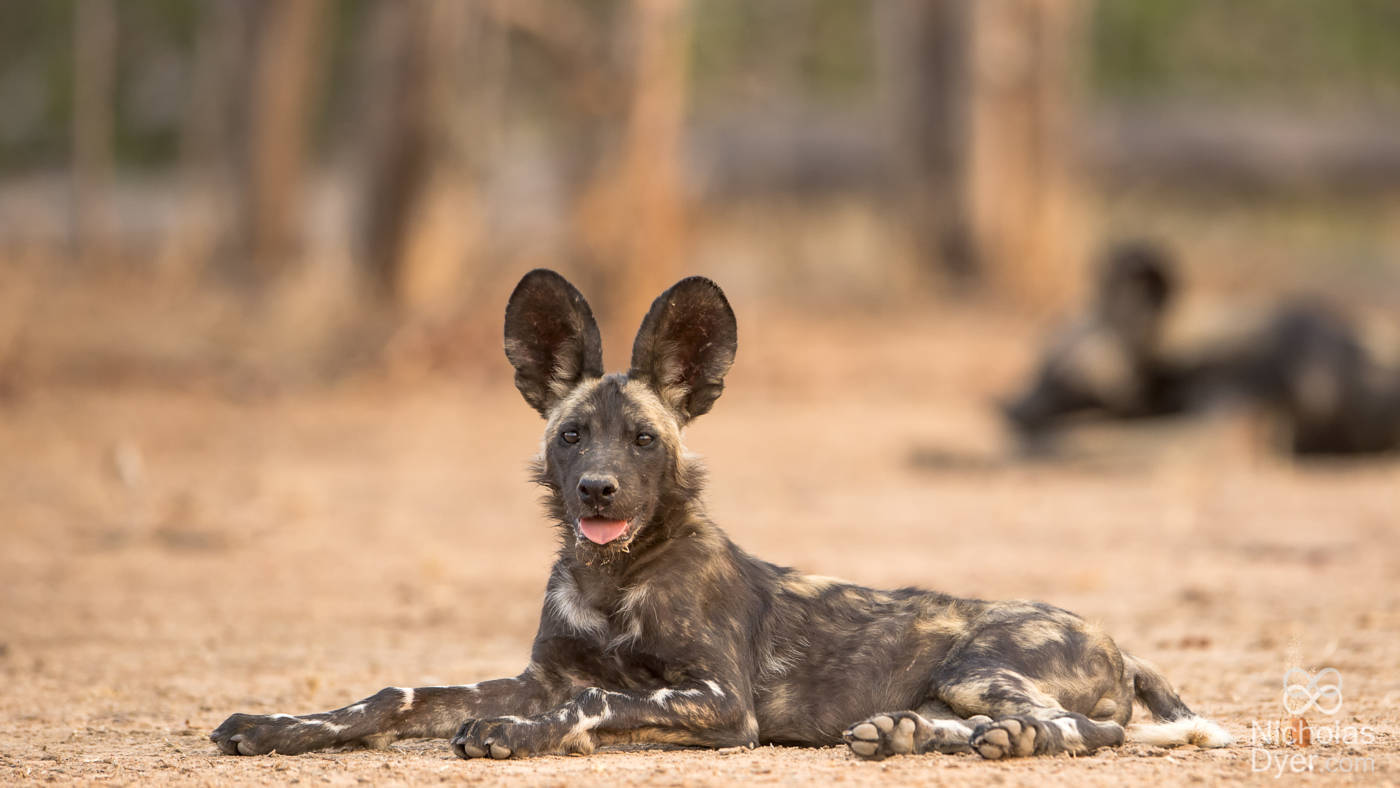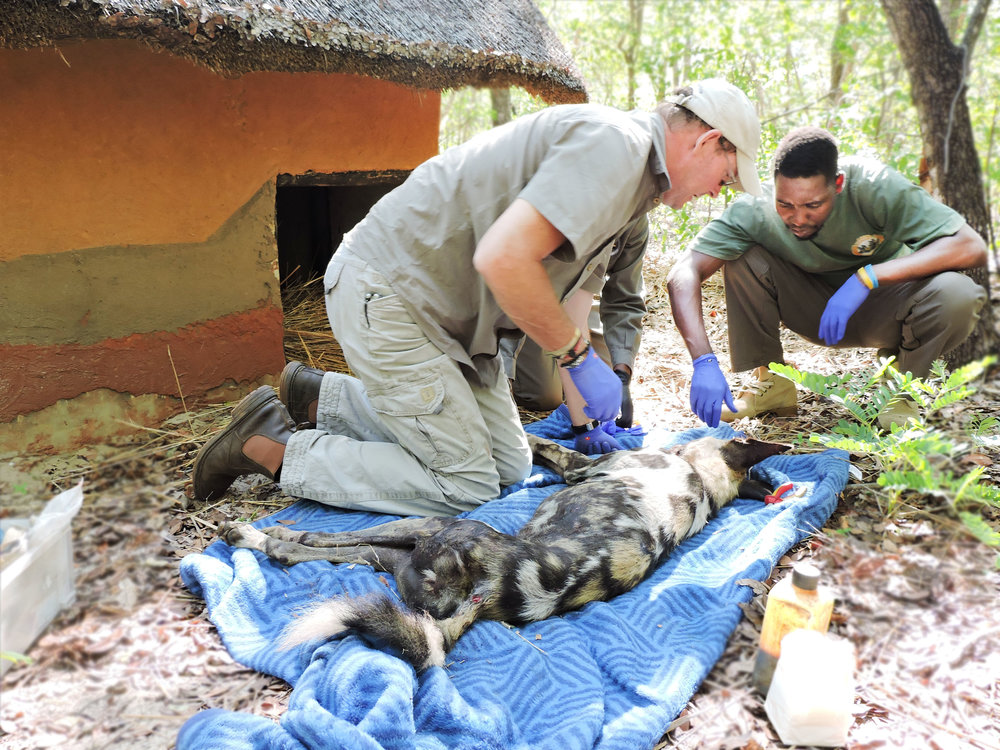The Zambezi Valley Conservation Network spoke to Painted Dog Conservation (PDC) Executive Director, Peter Blinston, to find out more about the goals and outcomes of the organisation’s research and monitoring of Painted Dog packs in Mana Pools and the Middle Zambezi.

Image: Painted Dog Conservation Website (www.painteddog.org)
Painted Dog Conservation (PDC), which began operations in Mana Pools and the Middle Zambezi Valley in 2010, was established 20 years ago in the Hwange National Park. Its overall vision is “to protect and increase the range and numbers of Painted Dogs (Lycaon pictus) in Zimbabwe.”
Based near Main Camp, Hwange, PDC now has some 65 staff members responsible for managing a variety of programmes including population monitoring, anti-poaching, income generation and a wide range of educational, interpretive and community outreach projects. These include a visitor centre, bush camps for children, school conservation clubs, and an HIV/AIDS programme that has built five clinics serving more than 20 000 people in communal areas surrounding the Park.
PDC began limited operations in the Mana Pools National Park in 2010, in response to a perceived decline of the Painted Dog population within the Park, and notably within the area commonly known as the “floodplain” (see footnote). Early operations were limited in scope, largely due to the difficulties involved in running the Mana operation from PDC’s Hwange base. However, in 2017 the Parks & Wildlife Management Authority asked PDC to expand its activities to include the entire Middle Zambezi Valley wildlife complex. This includes the Sapi, Chewore, Dande, Doma, Hurungwe and Charara Safari areas, and of course Mana Pools itself. PDC therefore opened an office close to ZPWMA’s Nyamepi headquarters with a current staff of two PDC employees, one of whom is currently studying for an MSc with PDC sponsorship.
PDC’s Zambezi Valley operation has three high-level objectives:
To gain insights into the demography of the Painted Dog population in the Middle Zambezi Valley. PDC intends to develop and maintain an ID database for all painted dogs in the Mana Pools National Park; and to develop and maintain an ID database for all painted dogs in the Middle Zambezi Valley to provide an annual population estimate and follow life histories of the packs.
- To gain insights into the demography of the Painted Dog population in the Middle Zambezi Valley. PDC intends to develop and maintain an ID database for all painted dogs in the Mana Pools National Park; and to develop and maintain an ID database for all painted dogs in the Middle Zambezi Valley.
- To gain insights into Painted Dog ecology in the Mana Pools National Park, by acquiring basic ecological knowledge in respect of home range sizes, habitat use, hunting success and prey preferences; and by developing more detailed knowledge of the effects of interspecific competition, notably with lion and hyaena.
- To gain insights into the genetic composition of the Middle Zambezi Painted Dog population, in collaboration with Stanford University, California. This will entail an evaluation of the genetic variability of the species in this area and of potential inbreeding issues such as sterility or vulnerability to disease.
This latter objective is still at an early stage of development. However, and despite a number of constraints and challenges, considerable progress has been made in respect of the other two objectives, in both Mana Pools and the broader Middle Zambezi Valley.
Information has been acquired by monitoring the population through several means, including the deployment of radio and satellite collars and the collation of sighting and anecdotal reports from safari operators and the public. In theory, satellite tracking, and the continuous flow of year-round data it can provide, is the most appropriate technology to adopt. Data derived from satellite collars has already shown that the extent of painted dog movement within the Zambezi Valley is far greater than previously thought, with pack ranges averaging over 700sq km.
Unfortunately, satellite tracking has proved to be highly problematic, largely due to the premature failure of the collars. It has therefore been virtually impossible to acquire data over the broader area during the wet season, resulting in periods of several months during which movements are virtually unknown. This may be at least partly remedied in future by the use of aerial tracking in collaboration with Flying for Wildlife, albeit hampered by a shortage of useable airstrips during the rains.

PDC began limited operations in the Mana Pools National Park in 2010, in response to a perceived decline of the Painted Dog population within the Park, and notably within the area commonly known as the “floodplain”. Image from www.painteddog.org
The most fundamental issue is the decline of the “floodplain” population from an estimated ±60 animals in the past, to 11 today. Current indications are that this decline has mainly been caused by a high density of competing carnivores, notably lion and hyaena, and unacceptable pressures on den sites by tourists and some safari operators.
However, as Blinston says, these are still “early days” for PDC in Mana and the Middle Valley, after only three years of work in these areas, compared with 20 years in Hwange; and it is not yet possible to derive firm conclusions from the research thus far carried out. There is a pressing need to acquire further data to confirm these preliminary findings and to gain a deeper understanding of the dynamics of the relationship between painted dogs and the lion and hyaena population. Only then will it be possible to identify appropriate management strategies to halt or reverse the decline in wild dog numbers.
Ultimately, though, Blinston also hopes to develop interpretive and community outreach programmes similar to those now in place in the Hwange National Park. Meanwhile, information concerning PDC activities is available to the public at their Mana Pools office.
________________________________________________________________________________________________________________
Footnote: Whatever may have been the case prior to the construction of the Kariba Dam, this area is not today subjected to regular annual inundation and is therefore not considered to be a true “floodplain”. It consists of a number of “river terraces” created by former Zambezi river channels as the river has slowly shifted its course northwards. The southern boundary of the area is clearly marked in several places, notably at Chine Pool, by an abrupt transition from the characteristically reddish older Karroo sediments to the much newer grey alluvial silts of the so-called “floodplain”.
For more information on PDCs Painted Dog research and conservation activities, visit www.painteddog.org
Written by Dick Pitman

